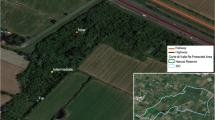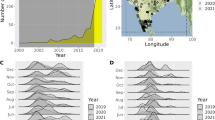Abstract
Night-migrating song birds travel to and from their wintering and breeding areas often separated thousands of kilometers apart and are clearly capable of finding intended goal areas from a distant location. Displacement experiments provide a useful way to highlight orientation and navigational skills in migrants. To investigate which cues birds actually use to compensate for displacement and the exact mechanism of each cue, experiments with manipulation of single cues are required. We conducted a simulated displacement of lesser whitethroats Sylvia curruca on spring migration. Birds were displaced not geographically but in geomagnetic space only, north and south of their breeding area to test whether they incorporate information from the geomagnetic field to find their breeding area. Lesser whitethroats held in southeast Sweden but experiencing a simulated displacement north of their breeding area (Norway) failed to show a consistent direction of orientation, whereas birds displaced south of their breeding area (Czech Republic) exhibited consistent northerly orientation, close to the expected seasonally appropriate direction, after displacement toward the trapping location. The absence of a clear compensatory direction in birds displaced north might be due to unfamiliar magnetic information or lack of sufficient information such as a magnetic gradient when moving around. By isolating one orientation cue, the geomagnetic field, we have been able to show that lesser whitethroats might incorporate geomagnetic field information to determine latitude during spring migration.


Similar content being viewed by others
References
Able KP (1982) Skylight polarization patterns at dusk influence migratory orientation in birds. Nature 288:550–551
Åkesson S (1994) Comparative orientation experiments with different species of passerine long-distance migrants—effect of magnetic field manipulation. Anim Behav 48:1379–1393
Åkesson S (1996) Geomagnetic map used for long-distance navigation? Trends Ecol Evol 11:398–400
Åkesson S, Morin J, Muheim R, Ottosson U (2001) Avian orientation at steep angles of inclination: experiments with migratory white-crowned sparrows at the magnetic North Pole. Proc R Soc Lond B 268:1907–1913
Åkesson S, Morin J, Muheim R, Ottosson U (2005) Dramatic orientation shift of white-crowned sparrows displaced across longitudes in the high arctic. Curr Biol 15:1591–1597
Batschelet E (1981) Circular statistics in biology. Academic, London
Beck W, Wiltschko W (1988) Magnetic factors control the migratory direction of pied flycatchers (Ficedula hypoleuca Pallas). In: Ouellet H (ed) Acta XIX Congr. Intern. Ornithol., vol 2. University of Ottawa Press, Ottawa, pp 1955–1962
Berthold P (1996) Control of bird migration. Chapman & Hall, London
Berthold P (2001) Bird migration. A general survey, 2nd edn. Oxford University Press, Oxford
Boles LC, Lohmann KJ (2003) True navigation and magnetic maps in spiny lobsters. Nature 421:60–63
Chernetsov N, Kishkinev D, Mouritsen H (2008) A long-distance avian migrant compensates for longitudinal displacement during spring migration. Curr Biol 18:1–3
Emlen ST (1970) Celestial rotation: its importance in the development of migratory orientation. Science 170:1198–1201
Fischer JH, Freake MJ, Borland SC, Phillips JB (2001) Evidence for the use of magnetic map information by an amphibian. Anim Behav 62:1–10
Fischer JH, Munro U, Phillips JB (2003) Magnetic navigation by an avian migrant? In: Berthold P, Gwinner E, Sonnenschein E (eds) Avian migration. Springer, Heidelberg, pp 141–154
Fisher NI (1993) Statistical analyses of circular data. Cambridge University Press, Cambridge
Fransson T, Hall-Karlsson S (2008) Swedish Bird Ringing Atlas, vol 3. Swedish Museum of Natural History, Stockholm
Fransson T, Jakobsson S, Johansson P, Kullberg C, Lind J, Vallin A (2001) Bird migration: magnetic cues trigger extensive refueling. Nature 414:35–36
Freake MJ, Muheim R, Phillips JB (2006) Magnetic maps in animals: a theory comes of age? Q Rev Biol 81:327–347
Gwinner E (1996) Circadian and circannual programmes in avian migration. J Exp Biol 199:39–48
International Association of Geomagnetism and Aeronomy (2005) The 10th generation international geomagnetic reference field. Division V, working group VMOD: geomagnetic field modeling. Geophys J Int 161:561–565
Kullberg C, Lind J, Fransson T, Jakobsson S, Vallin A (2003) Magnetic cues and time of season affect fuel deposition in migratory thrush nightingales, Luscinia luscinia. Proc R Soc Lond B 270:373–378
Kullberg C, Henshaw I, Jakobsson S, Johansson P, Fransson T (2007) Fuelling decisions in migratory birds: geomagnetic cues override the seasonal effect. Proc R Soc Lond B 274:2145–2151
Lohmann KJ, Lohmann CMF (1994) Detection of magnetic inclination angle by sea turtles: a possible mechanism for determining latitude. J Exp Biol 194:23–32
Lohmann KJ, Lohmann CMF (1996) Detection of magnetic field intensity by sea turtles. Nature 380:59–61
Lohmann KJ, Hester JT, Lohmann CMF (1999) Long-distance navigation in sea turtles. Ethol Ecol Evol 11:1–23
Lohmann KJ, Cain SD, Dodge SA, Lohmann CMF (2001) Regional magnetic fields as navigational markers for sea turtles. Science 294:364–366
Lohmann KJ, Lohmann CMF, Ehrhart LM, Bagley DA, Swing T (2004) Geomagnetic map used in sea-turtle navigation. Nature 428:909–910
Lohmann KJ, Lohmann CMF, Putman N (2007) Magnetic maps in animals: nature’s GPS. J Exp Biol 210:3697–3705
Lohmann KJ, Putman NF, Lohmann CMF (2008) Geomagnetic imprinting: a unifying hypothesis of long-distance natal homing in salmon and sea turtles. Proc Natl Acad Sci USA 105:19096–19101
Merkel FW, Wiltschko W (1965) Magnetismus und Richtungsfinden zugunruhiger Rotkehlchen, Erithacus rubecula. Vogelwarte 23:71–77
Mewaldt RL (1964) California sparrows return from displacement to Maryland. Science 146:941–942
Moore FR (1987) Sunset and the orientation behavior of migratory birds. Biol Rev Camb Philos Soc 62:65–86
Mouritsen H (2003) Spatiotemporal orientation strategies of long-distance migrants. In: Berthold P, Gwinner E, Sonnenschein E (eds) Avian migration. Springer, Heidelberg
Muheim R, Phillips JB, Akesson S (2006) Polarized light cues underlie compass calibration in migratory songbirds. Science 313:837–839
Perdeck AC (1974) An experiment on the orientation of juvenile starlings during spring migration. Ardea 62:190–195
Phillips JB, Freake MJ, Fischer JH, Borland SC (2002) Behavioral titration of magnetic map coordinate. J Comp Physiol 188:157–160
Phillips JB, Muheim R, Schmidt-Koenig K (2006) True navigation: sensory base of a gradient maps. In: Brown MF, Cook RG (eds) Animal spatial cognition: behavioral, comparative, computational and neural approaches (on-line). Available: www.pigeon.psy.tufts.edu/asc/phillips/
Ritz T, Adem S, Schulten K (2000) A model for photoreceptor-based magnetoreception in birds. Biophys J 78:707–718
Schmidt-Koenig K (1990) The sun compass. Experientia 46:336–342
Skiles DD (1985) The geomagnetic field its nature, history, and biological relevance. In: Kirschvink JLM (ed) Magnetic biomineralization and magnetoreception in organisms. Plenum, London
Svensson L (1992) Identification guide to European passerines. British Trust for Ornithology, Tring
Thorup K, Bisson I-A, Bowlin MS, Holland RA, Wingfield JC, Ramenofsky M, Wikelski M (2007) Evidence for a navigational map stretching across the continental U.S. in a migratory songbird. Proc Natl Acad Sci USA 104:18115–18119
Wiltschko W (1968) Über den Eisenfluß statischer Magnetfelder auf die Zugorientierung der Rotkehlchen, Erithacus rubecula. Z Tierpsychol 25:537–558
Wiltschko W, Wiltschko R (1972) Magnetic compass of European robins. Science 176:62–64
Wiltschko W, Wiltschko R (1992) Migratory orientation: magnetic compass orientation of garden warblers (Sylvia borin) after a simulated crossing of the magnetic equator. Ethol 91:70–74
Acknowledgments
We thank Thomas Giegold for technical assistance, Landsort Bird Observatory, and Per Johansson for help with trapping birds, and Rachel Muheim for useful discussions and use of Birdtrack software for analysis of orientation video recordings. We also thank two anonymous referees for useful comments. Funding was received from the Swedish Research Council (to C.K.) and from August Emil Wilhelm Smitts Stipendium, Kungliga Vetenskapsakadamien, and Helge Ax:son Johnsons Stiftelse (to I.H.). The study was carried out with permission from the Swedish Animal Welfare Agency (permission no: 41-07).
Author information
Authors and Affiliations
Corresponding author
Additional information
Communicated by: T. Czeschlik
Rights and permissions
About this article
Cite this article
Henshaw, I., Fransson, T., Jakobsson, S. et al. Geomagnetic field affects spring migratory direction in a long distance migrant. Behav Ecol Sociobiol 64, 1317–1323 (2010). https://doi.org/10.1007/s00265-010-0946-8
Received:
Revised:
Accepted:
Published:
Issue Date:
DOI: https://doi.org/10.1007/s00265-010-0946-8




